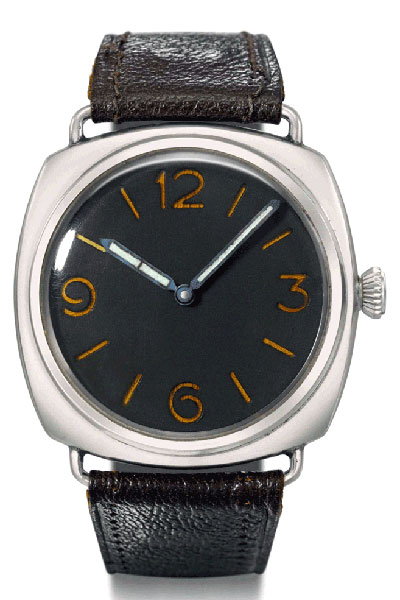I might as well start by stating the obvious: in a war there are deaths, injuries, destruction, blood, horror and then… peace.
But war fascinates us. Although negative, its force nevertheless remains an attraction and a world that interests, disturbs and enthralls us. Above and beyond the cruelty of any war, there is an element of heroism, of courage, adventure and surpassing oneself. Whatever the conflict, there will always be heroes. There will be stories told for years to come. Some names will be celebrated, while others will quickly be forgotten.
War is as old as humanity. As is the measurement of time, by the way. As a result, they both have a lot of common history. As war became more modern, it needed more precision and more measurement. The watch therefore became an indispensable element in any war and for any soldier. In some cases, it was even a military secret.
A lot of watch brands found themselves wound up in conflicts, with roles both minor and crucial. Some ended up, without their knowledge, on the wrists of soldiers, others forged partnerships with states and their armed forces.
The military watch has thus become a highly sought-after item among collectors. This is because it embodies everything that watch lovers are looking for: there is the watch itself, its technical dimension, its characteristics and its innovations. Then there is its history, what it has lived through and what it conveys. Finally, there is the person who wore it, his battles, his life – and sometimes his death.
Modern warfare created the need for watches to meet the requirements of different armed forces. These timepieces have their origins in the navy and the marine chronometers installed in ships that plied – and fought on – the world’s oceans. But these chronometers were instruments that were part of the ship, rather than purely military items.
As conflicts started to involve more technology, however, there was a need for watches to be worn by soldiers. The first world war saw the first officer and trench watches, which were used to coordinate different activities. It was the first conflict where strategists and officers were away from the front lines. So communication lines had to be improved and the need to have a common and shared time gained importance from a military perspective.
Some functions also became indispensable on the battlefield. The small seconds is one example. Its presence shows that the watch is working and is a guarantee of coordination and efficiency, and sometimes of survival.
Then there are the pilots, artillerymen and submariners...
Just as everyone was dreaming of peace, the second world war broke out. With its new requirements (combat divers) and its technical progress. Once again, the watch was set to play an important role, on the wrists of combatants on both sides.
The GIs had their Hamiltons, the British wore the “dirty dozen” ordered by the Ministry of Defence (MOD) – Buren, Cyma, Eterna, Grana, Jaeger-LeCoultre, IWC, Lemania, Longines, Omega, Record, Timor and Vertex – the pilots of the Luftwaffe had their IWC, Tutima, Hanhardt, Laco and Stowa and the kamikazes wore Seikosha.
Later there were other conflicts with other watches: Benrus, Glycine, Tornek-Rayville, Bulova and Seiko in Vietnam, Dodane and Breguet Type XX for the French pilots, Rolex, Omega and CWC for British combat divers and Zlatoust for Soviet frogmen. Today the majority of soldiers active in different theatres wear the Casio G-Shock. But the list of military watches is of course much longer than these few names.
With all this interconnected military and watchmaking history, there is one question that is rarely asked. In a conflict there are winners and losers, the good and the bad, heroes and criminals. As part of a soldier’s equipment the watch is involved in combat and therefore runs the risk of being associated with one or the other. It can therefore become an object of celebration or recognition. Watch brands therefore have to navigate potentially choppy waters. When “their” watch might be associated with the winners or the heroes, there is of course no problem. But what happens when the same watch is worn by the losers, the criminals?
This brings us to the heart of the matter…
Why Panerai?
Panerai played a fundamental role in military history. The Italian brand developed the first watch that was intended exclusively for military use: the famous 3646. This was not just a purely military timepiece, it was also a military secret for a number of years, such was its importance in the success of secret navy diver missions by the Decima Flotigglia MAS (Mezzi d’Assalto).
Established in 1939, this combat diver unit was involved in a number of operations during the second world war. Between 1940 and 1943, its men fought alongside the Germans and sank a number of allied ships, often using human torpedoes (“maiale”).
From 1943 the story becomes more complicated. As the Allies made progress in Italy, the regime changed and the Italian troops, including the Decima MAS, switched sides. But some of them chose to stay on the other side and continued to fight alongside the German troops, still wearing their Panerais.
As the war was drawing to a close, Panerai continued to supply other armed forces, then slowly became dormant. It was revived only decades later and became one of the great success stories of modern watchmaking history. For many years Panerai used its military history to promote its large watches and and it still does so today. What is unique about the brand is this close link with the second world war. But also the fact that Panerai not only did not hide it, but actively promoted it. We can all remember the famous advertisement with a combat diver wearing a PAM. It is an image that is etched on the brand of all Paneristi and was often responsible for their initial interest in the brand.
Yet again, war fascinates.
The story of the Decima MAS is of particular interest here. Even though the men fought with the Axis powers, they had recognition and even admiration from all sides. It is such respect that allowed them to emerge alongside the victors at the end of the second world war. So associating Panerai with this unit was a risky gamble, but it paid off. But the story doesn’t end there! This is why I am going to present two watches: The Panerai 720 and 721.
Panerai PAM 720 and 721: diver’s watches in troubled waters
The 3646 was standard issue for the men of the Decima MAS. They wore reference B.
But they were also worn by the German divers, the renowned Kampfschwimmer (KSM). This unit was set up in 1943 and was active mainly towards the end of the second world war. And who do you think trained these first German marine commandos? The men of the Decima MAS. So it is little surprise that they shared their equipment, including their watches, which meant that the KSM also wore Panerais.
They were identical to those worn by their Italian colleagues with just one exception: there was no logo on the dial, no brand name, nothing. It was empty, simple, non-identifiable and therefore anonymous. It was the 3646 D.

In 2017 Panerai presented two limited editions at the SIHH: the 720 (500 pieces) and the 721 (1000 pieces). These two models were almost identical re-issues of the 3646. Both of these models have all the aesthetic characteristics of the first military diver’s watch in history: the 47mm cushion-shaped case, the highly legible sandwich dial, the oversized 3, 6, 9, 12 numerals, blued hands, screw-in crown and fine lugs. Both are water resistant to 100 metres.
Just two things distinguish the 720 from the 721. The strap (lighter in colour on the 720) and the lack of any markings on the dial for the 721. PAM 720 keeps the historical “Radiomir Panerai” inscription on the dial. This “logo” model was worn by the divers of the Decima MAS (reference 3646 Type B). The “Anonymous” was worn by the KSM (reference 3646 Type D).
Apart from this, the two models are the same. They are both fitted with a splendid thick leather strap that goes perfectly with the watch. The original watches were also fitted with leather straps that needed to withstand intense underwater use, which is why they were so thick.
The movement is the now classic manually wound P3000. It’s a simple calibre and offers three days of power reserve. The original 3646 was fitted with a Rolex movement. The case back is in sapphire crystal, which reveals the movement, and is surrounded by the inscription “Officine Panerai Brevettato”.
Of course its size is imposing. It’s a Panerai, so it should be.
I think these two watches are among the most beautiful in the current collection. Their place in horological history, their simple design and the Panerai signatures make them a must-have for any collector interested in the brand or in military watches in general.
There are just a few things that might dampen their enthusiasm, so it’s time to hand over to the devil’s advocate.
What does the devil’s advocate think?
This subheading has never been so justified. One of the things that may make future buyers think twice is the historical, or ideological, connection, in particular for the Panerai 721.
I have talked about this with a few collector friends and opinions differ. Nevertheless, the historical significance takes precedence and these two watches deserve a place in a collection and on your wrist. But I think it is important to understand their place in history before buying them. These are not watches that should be bought on a whim. They need to be understood and accepted.
The other things that the devil’s advocate could point out are the size (47mm) and the use of a transparent case back. The 47mm cases are big, but they have their historical legitimacy. So the 720 and 721 should respect this diameter. This may put some people off, but I have a small wrist and I would wear them without hesitation. The transparent case back is a real concern. The P3000 is a simple calibre and I would have preferred a full case back like on the original 1940s model.
How to wear the Panerai PAM 720 and 721?
There are two ways to show off these watches.
The first is to accentuate its military character. Choose a strap that looks even more vintage (the best are by Gunny Straps or Kostas Straps), light beige cargo pants by Brunello Cucinelli and a simple black T-shirt. A pair of Nike Air Max VT or SP (2012 or 2013) sneakers would be perfect, if you can find one! If you want to keep the military theme but add a little fun, go for a Brooks Brothers Red Fleece camouflage blazer or a Jay Kos suit. But if you do this, leave any other camouflage items in the locker room. A chambray shirt is the best option with the jacket, or a T-shirt and white sneakers with the suit.
You can, however, also “demilitarise” your Panerai and your look. This allows you to distance yourself from its origins. Panerai fundamentalists will probably be shocked, but it’s something worth considering. First of all you need to change the strap. And why not add a splash of colour? There is only one option: bespoke from Combat Straps (Aaron Pimentel) to choose the material and colour to make your Panerai less bellicose. Match your watch with colourful chinos (how about pink, if you’re in a summery mood?), a T-shirt with a Tunisian collar by Zadig & Voltaire and Tod’s Gomino in distressed denim. If you’re going out, add a blazer by Boglioli, which will always be an Italian classic.
Then it’s time to catch the last rays of sunshine with a Trieste Spritz.
With peace of mind you can take a few moments to consider how lucky you are not to have to wear this watch in its original context.





